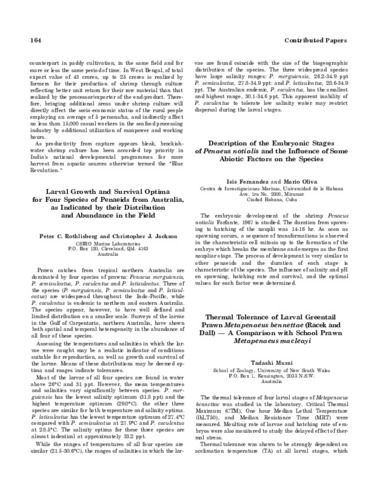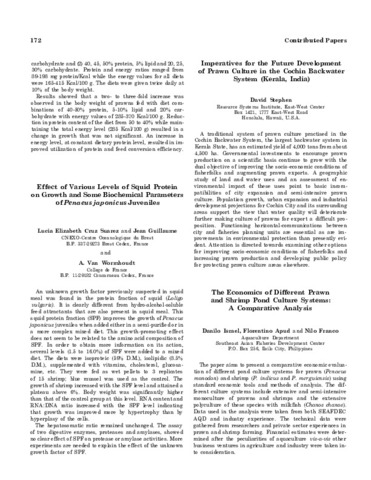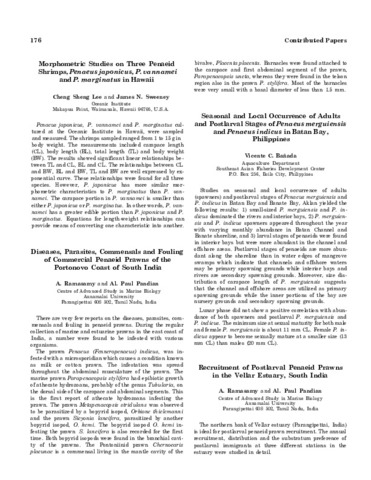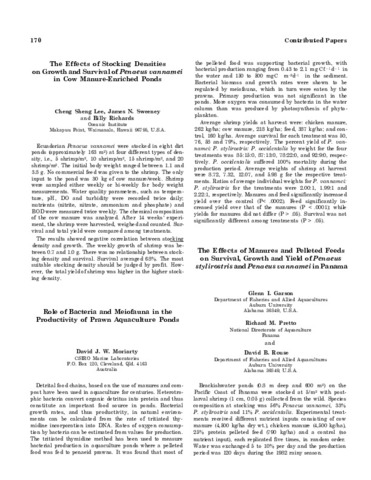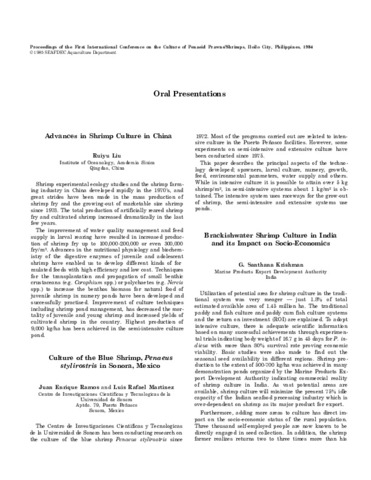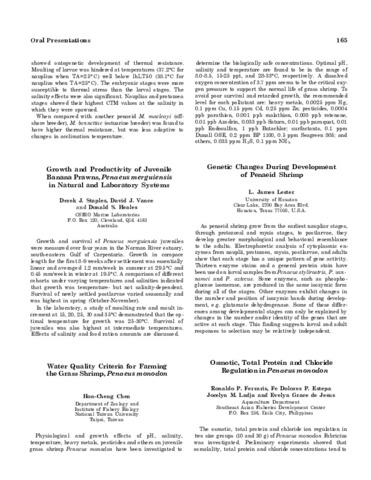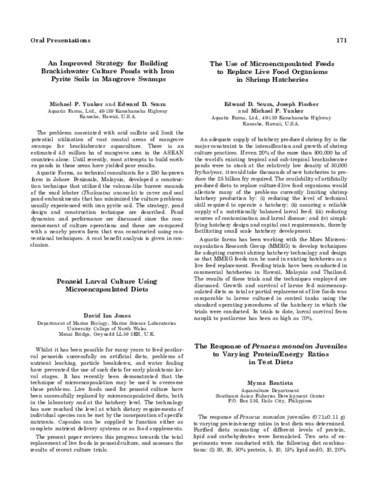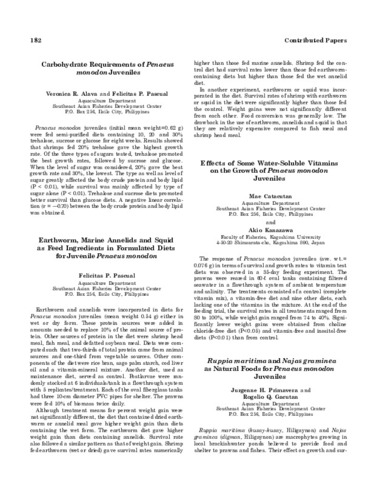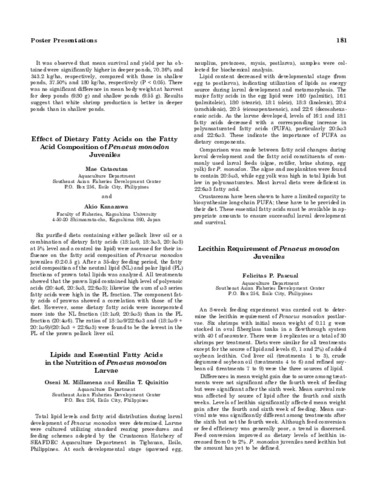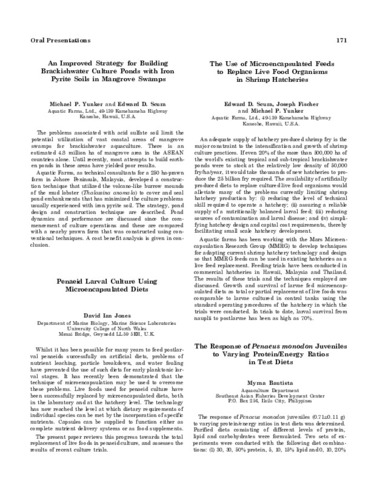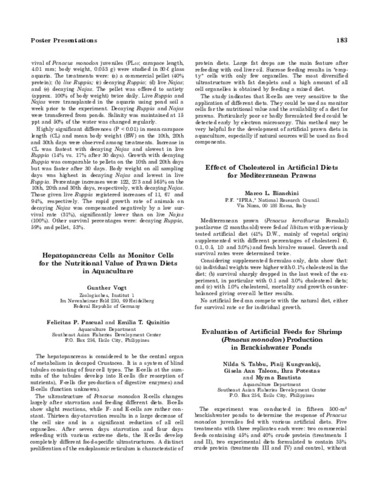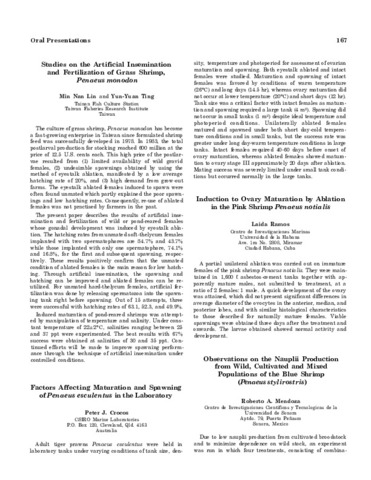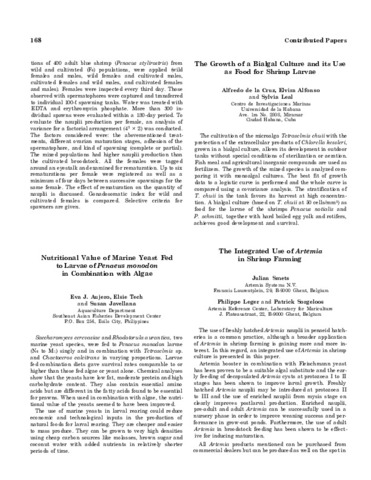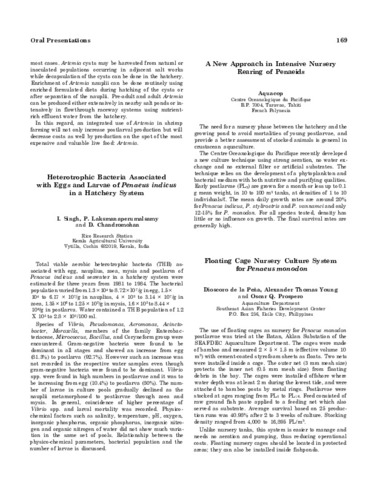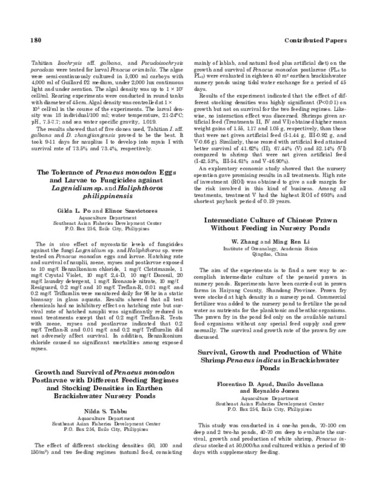Proceedings of the First International Conference on the Culture of Penaeid Prawns/Shrimps: Recent submissions
41-60 / 79
-
Studies on the artificial insemination and fertilization of grass shrimp, Penaeus monodon
(Aquaculture Department, Southeast Asian Fisheries Development Center, 1985)The culture of grass shrimp, Penaeus monodon has become a fast-growing enterprise in Taiwan since formulated shrimp feed was successfully developed in 1978. In 1983, the total postlarval production for stocking reached 600 ... -
Description of the embryonic stages of Penaeus notialis and the influence of some abiotic factors on the species
(Aquaculture Department, Southeast Asian Fisheries Development Center, 1985)The embryonic development of the shrimp Penaeus notialis Farfante, 1967 is studied. The duration from spawning to hatching of the nauplii was 14-16 hr. As soon as spawning occurs, a sequence of transformations is observed ... -
The economics of different prawn and shrimp pond culture systems: A comparative analysis
(Aquaculture Department, Southeast Asian Fisheries Development Center, 1985)The paper aims to present a comparative economic evaluation of different pond culture systems for prawn (Penaeus monodon) and shrimp (P. indicus and P. merguiensis) using standard economic tools and methods of analysis. ... -
Morphometric studies on three Penaeid shrimps, Penaeus japonicus, P. vannamei and P. marginatus in Hawaii
(Aquaculture Department, Southeast Asian Fisheries Development Center, 1985)Penaeus japonicus, P. vannamei and P. marginatus cultured at the Oceanic Institute in Hawaii, were sampled and measured. The shrimps sampled ranged from 1 to 15 g in body weight. The measurements included carapace length ... -
The effects of stocking densities on growth and survival of Penaeus vannamei in cow manure-enriched ponds
(Aquaculture Department, Southeast Asian Fisheries Development Center, 1985)Ecuadorian Penaeus vannamei were stocked in eight dirt ponds (approximately 163 m2) at four different types of density, i.e., 5 shrimp/m2, 10 shrimp/m2, 15 shrimp/m2, and 20 shrimp/m2. The initial body weight ranged between ... -
Brackishwater shrimp culture in India and its impact on socio-economics
(Aquaculture Department, Southeast Asian Fisheries Development Center, 1985)Utilization of potential area for shrimp culture in the traditional system was very meager — just 1.8% of total estimated available area of 1.45 million ha. The traditional paddy and fish culture and paddy cum fish culture ... -
The effects of manures and pelleted feeds on survival, growth and yield of Penaeus stylirostris and Penaeus vannamei in Panama
(Aquaculture Department, Southeast Asian Fisheries, Development Center, 1985)Brackishwater ponds (0.8 m deep and 600 m2) on the Pacific Coast of Panama were stocked at 5/m2 with post-larval shrimp (1 cm, 0.05 g) collected from the wild. Species composition at stocking was 56% Penaeus vannamei, 33% ... -
Genetic changes during development of penaeid shrimp
(Aquaculture Department, Southeast Asian Fisheries Development Center, 1985)As penaeid shrimp grow from the earliest naupliar stages, through protozoeal and mysis stages, to postlarvae, they develop greater morphological and behavioral resemblance to the adults. Electrophoretic analysis of cytoplasmic ... -
Osmotic, total protein and chloride regulation in Penaeus monodon
(Aquaculture Department, Southeast Asian Fisheries Development Center, 1985)The osmotic, total protein and chloride ion regulation in two size groups (10 and 30 g) of Penaeus monodon Fabricius was investigated. Preliminary experiments showed that osmolality, total protein and chloride concentrations ... -
Penaeid larval culture using microencapsulated diets
(Aquaculture Department, Southeast Asian Fisheries Development Center, 1985)Whilst it has been possible for many years to feed postlar-val penaeids successfully on artificial diets, problems of nutrient leaching, particle breakdown, and water fouling have prevented the use of such diets for early ... -
Effects of some water-soluble vitamins on the growth of Penaeus monodon juveniles
(Aquaculture Department, Southeast Asian Fisheries Development Center, 1985)The response of Penaeus monodon juveniles (ave. wt.= 0.076 g) in terms of survival and growth rates to vitamin test diets was observed in a 35-day feeding experiment. The prawns were reared in 60-ℓ oval tanks containing ... -
Effect of dietary fatty acids on the fatty acid composition of Penaeus monodon juveniles
(Aquaculture Department, Southeast Asian Fisheries Development Center, 1985)Six purified diets containing either pollack liver oil or a combination of dietary fatty acids (18:1ω9, 18:3ω3, 20:5ω3) at 5% level and a control (no lipid) were assessed for their influence on the fatty acid composition ... -
The response of Penaeus monodon juveniles to varying protein/energy ratios in test diets
(Aquaculture Department, Southeast Asian Fisheries Development Center, 1985)The response of Penaeus monodon juveniles (0.71±0.11 g) to varying protein/energy ratios in test diets was determined. Purified diets consisting of different levels of protein, lipid and carbohydrates were formulated. Two ... -
Effect of cholesterol in artificial diets for Mediterranean prawns
(Aquaculture Department, Southeast Asian Fisheries Development Center, 1985)Mediterranean prawn (Penaeus kerathurus Forsskal) postlarvae (2 months old) were fed ad libitum with previously tested artificial diet (41% D.W., mainly of vegetal origin) supplemented with different percentages of cholesterol ... -
Factors affecting maturation and spawning of Penaeus esculentus in the laboratory
(Aquaculture Department, Southeast Asian Fisheries Development Center, 1985)Adult tiger prawns Penaeus esculentus were held in laboratory tanks under varying conditions of tank size, density, temperature and photoperiod for assessment of ovarian maturation and spawning. Both eyestalk ablated and ... -
Water quality criteria for farming the grass shrimp, Penaeus monodon
(Aquaculture Department, Southeast Asian Fisheries Development Center, 1985)Physiological and growth effects of pH, salinity, temperature, heavy metals, pesticides and others on juvenile grass shrimp Penaeus monodon have been investigated to determine the biologically safe concentrations. Optimal ... -
The growth of a bialgal culture and its use as food for shrimp larvae
(Aquaculture Department, Southeast Asian Fisheries Development Center, 1985)The cultivation of the microalga Tetraselmis chuii with the protection of the extracellular products of Chlorella kessleri, grown in a bialgal culture, allows its development in outdoor tanks without special conditions of ... -
Floating cage nursery culture system for Penaeus monodon
(Aquaculture Department, Southeast Asian Fisheries Development Center, 1985)The use of floating cages as nursery for Penaeus monodon postlarvae was tried at the Batan, Aklan Substation of the SEAFDEC Aquaculture Department. The cages were made of bamboo and measured 2 × 5 × 1.5 m (effective volume ... -
Carbohydrate requirements of Penaeus monodon juveniles
(Aquaculture Department, Southeast Asian Fisheries Development Center, 1985)Penaeus monodon juveniles (initial mean weight=0.62 g) were fed semi-purified diets containing 10, 20 and 30% trehalose, sucrose or glucose for eight weeks. Results showed that shrimps fed 20% trehalose gave the highest ... -
Survival, growth and production of white shrimp Penaeus indicus in brackishwater ponds
(Aquaculture Department, Southeast Asian Fisheries Development Center, 1985)This study was conducted in 4 one-ha ponds, 70-100 cm deep and 2 two-ha ponds, 40-70 cm deep to evaluate the survival, growth and production of white shrimp, Penaeus indicus stocked at 50,000/ha and cultured within a period ...


